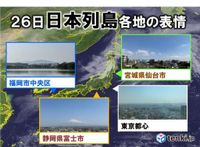On March 25, 2025, yellow dust was observed in Osaka for the first time this year, marking the beginning of a seasonal phenomenon that affects large parts of Japan. The Japan Meteorological Agency reported that yellow dust, which is carried by westerly winds from deserts in East Asia, reached Osaka at 6 AM, with visibility reported at over 10 kilometers. This dust is expected to spread across northern and western Japan, impacting outdoor activities on March 26.
Yellow dust, also known as Asian dust, consists of fine particles blown from desert regions, primarily in China and Mongolia. As spring approaches, these winds become more prevalent, bringing the dust across the Sea of Japan and into the Japanese archipelago. The arrival of yellow dust can lead to various health issues, particularly for individuals with respiratory conditions or allergies. The Ministry of the Environment warns that symptoms such as eye itching, conjunctivitis, runny noses, and sneezing may be exacerbated during this time.
On March 26, the yellow dust continued to be observed in both Tokyo and Osaka, as confirmed by the Japan Meteorological Agency's yellow dust information. Reports indicate that the phenomenon has also been noted in a wide range of areas including Tohoku, Kanto, Tokai, and Kansai. The visibility in these regions may decrease significantly, raising concerns about potential traffic disruptions if visibility falls below 5 kilometers.
As the yellow dust peaks, it is crucial for residents to take precautions. The Ministry of the Environment recommends that individuals limit outdoor activities, especially strenuous exercise, during high concentrations of yellow dust. Vulnerable populations, including children, the elderly, and those with pre-existing health conditions, should be especially cautious. Keeping windows closed and drying laundry indoors are also advised to avoid contamination from the dust.
Moreover, wearing masks can provide a degree of protection against inhaling the fine particles. The Ministry suggests using well-fitting masks to minimize air leakage, thus enhancing their effectiveness. As the yellow dust phenomenon continues, it is essential for individuals to stay informed about the latest forecasts and advisories.
Looking ahead, yellow dust is expected to arrive in regions such as Shikoku, Kansai, Hokuriku, Tokai, Kanto Koshinetsu, and parts of Tohoku on March 27, although the concentration is anticipated to be lower than in the previous days. As the dust settles, the peak of this environmental issue is gradually passing, but the effects linger, reminding residents of the importance of health precautions during this seasonal occurrence.
As residents of Japan brace for the ongoing presence of yellow dust, it serves as a stark reminder of the interconnectedness of environmental phenomena and public health. The seasonal winds that bring dust from across the sea not only impact visibility but also pose significant health risks, emphasizing the need for awareness and preparedness in the face of nature's unpredictability.
In summary, the observation of yellow dust in Osaka on March 25 marks the start of a period that requires vigilance and caution among the population. With health authorities urging residents to take necessary precautions, the spread of yellow dust serves as a reminder of the seasonal changes that can affect daily life in Japan.




